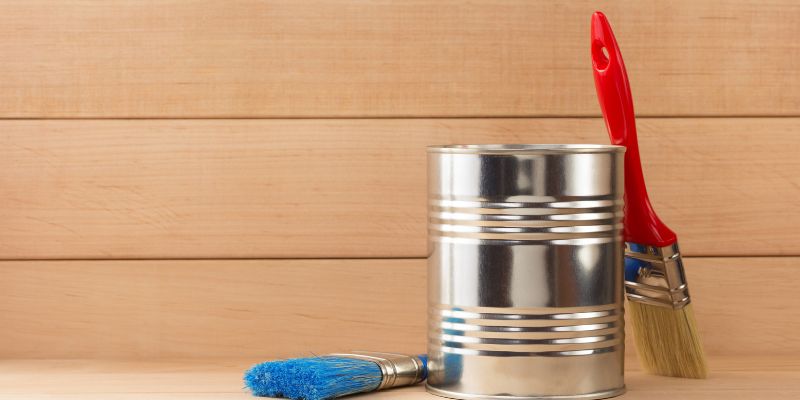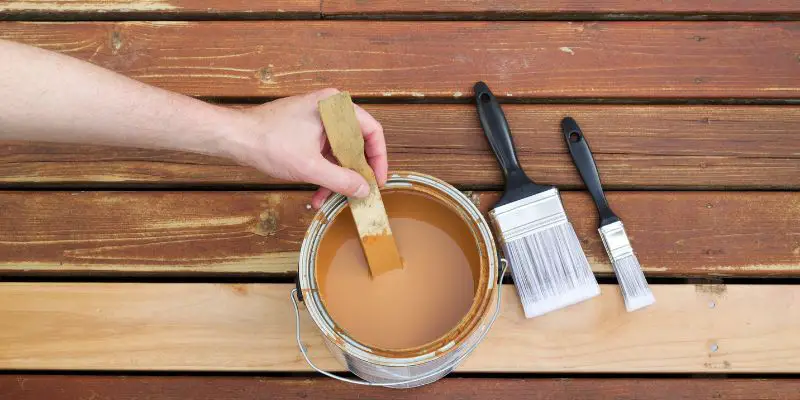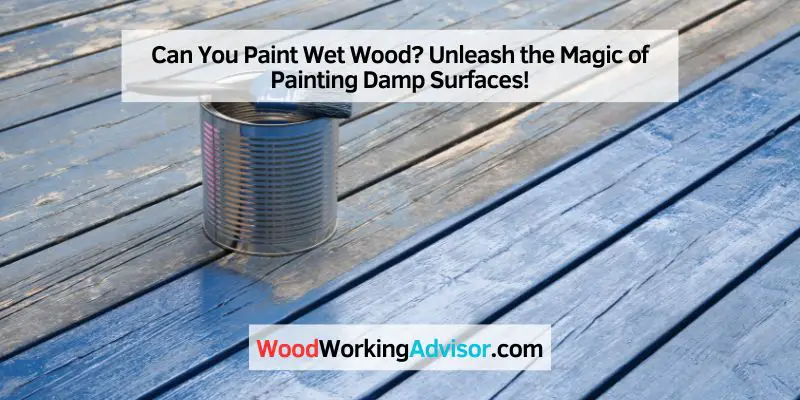No, you cannot paint wet wood.
Preparing Wet Wood For Painting
When it comes to painting wet wood, it’s important to properly prepare the surface to ensure a smooth and long-lasting finish. By taking the necessary steps to remove moisture and applying a wood primer, you can create a strong foundation for your paint to adhere to. In this article, we will discuss the important steps involved in preparing wet wood for painting, including removing moisture and applying wood primer.
Removing Moisture
Before you begin painting wet wood, it is crucial to remove as much moisture as possible. Moisture can interfere with the adhesion of paint, leading to peeling or bubbling in the future. To remove moisture from wet wood, follow these steps:
- Begin by gently wiping the surface of the wood with a clean, dry cloth to remove any excess water. This will help to speed up the drying process.
- Place fans or dehumidifiers in the area to increase air circulation and promote faster drying. Remember to properly ventilate the room to avoid the buildup of moisture.
- If the wood is extremely wet or waterlogged, you may need to allow it to dry naturally for a few days before proceeding with painting.
Applying Wood Primer
Once the wet wood has dried and is ready for painting, the next step is to apply a wood primer. A wood primer will help to seal the surface, provide better adhesion for the paint, and protect the wood from moisture damage. Follow these guidelines while applying wood primer:
- Clean the surface with a mild soap and water solution to remove any dirt or debris. Rinse thoroughly and allow it to dry completely before applying the primer.
- Using a paintbrush or roller, apply a thin and even coat of wood primer to the surface of the wood. Make sure to reach all the nooks and crannies for full coverage.
- Allow the primer to dry according to the manufacturer’s instructions. This typically takes about 24 hours.
- After the primer has dried, lightly sand the surface with a fine-grit sandpaper to smooth out any imperfections and create a smooth surface for the paint.
By following these steps to remove moisture and applying a wood primer, you can ensure that your paint will adhere properly to wet wood, providing a durable and attractive finish. Remember to choose a high-quality paint that is suitable for exterior or interior use, depending on your project’s requirements. With the right preparation, your wet wood can be transformed into a beautifully painted surface that will last for years to come.

Choosing The Right Paint For Wet Wood
When it comes to painting wet wood, choosing the right paint is crucial for achieving a long-lasting and beautiful finish. While it may seem challenging to find a paint that adheres well to wet surfaces, there are options available that can withstand even the dampest conditions. In this article, we will explore the differences between acrylic and oil-based paint and delve into the various exterior paint options that are suitable for wet wood.
Understanding Acrylic Vs. Oil-based Paint
Acrylic and oil-based paints are two popular choices for outdoor painting projects. Understanding their differences can help you make an informed decision when it comes to painting wet wood.
Acrylic paint is water-based and provides excellent durability and flexibility, making it an ideal choice for wet wood surfaces. Its quick-drying nature allows for faster project completion, minimizing the risk of moisture damage. Additionally, acrylic paint is known for its resistance to cracking and peeling, ensuring that your paint job will last for years to come.
On the other hand, oil-based paint is made with linseed oil or other types of oils, providing superior protection against the elements. Its natural oil content allows it to penetrate deep into the wood, providing a protective barrier against moisture and preventing rot and decay. While oil-based paint takes longer to dry compared to acrylic paint, it offers exceptional durability and a glossy finish that can enhance the natural beauty of the wood.
Exploring Exterior Paint Options
When it comes to choosing the right exterior paint for wet wood, there are a few options that are worth considering:
1. Water-Resistant Latex Paint:
Water-resistant latex paint is specifically designed to resist moisture and can be an excellent choice for painting wet wood. Its acrylic base provides a strong bond and allows for the expansion and contraction of the wood without cracking or peeling. Look for latex paints that are labeled as “mildew-resistant” or “waterproof” for optimal protection against moisture damage.
2. Oil-Based Primer and Paint:
If you prefer the traditional look and superior protection of oil-based paint, consider using an oil-based primer followed by an oil-based paint. The primer will help seal the wood and create a smooth surface for the paint to adhere to, ensuring long-lasting results. Keep in mind that oil-based paints require longer drying times and proper ventilation during application.
3. Epoxy Paint:
Epoxy paint is a highly durable and waterproof option that can withstand even the wettest conditions. It forms a strong chemical bond with the wood surface, creating a resilient barrier against moisture, UV rays, and chemicals. Epoxy paint is an excellent choice for areas that are constantly exposed to water, such as decks and docks.
In conclusion, choosing the right paint for wet wood is essential for a successful and durable paint job. Whether you opt for acrylic paint, oil-based paint, or epoxy paint, ensure that it is specifically designed to resist moisture and provide long-lasting protection. By understanding the differences between these paint options, you can make an informed decision and achieve a beautiful finish that withstands the test of time.
Techniques For Painting Wet Wood
When painting wet wood, there are different techniques to consider. One important decision to make is whether to use a brush or spray applicator. Each method has its benefits and considerations when dealing with wet surfaces.
One of the key challenges in painting wet wood is managing the drying time. Since the wood is wet, it will naturally take longer to dry. However, there are certain strategies and products that can help expedite the drying process, ensuring a successful paint application.
Safety Precautions For Painting Wet Wood
When it comes to painting wet wood, it’s important to take the necessary safety precautions. Painting wet wood can be challenging, but by following the right steps, you can achieve a beautiful and long-lasting finish. In this section, we will discuss two important safety precautions that you should adhere to: avoiding mold and mildew and protecting yourself from fumes.
Avoiding Mold And Mildew
Mold and mildew can thrive on damp surfaces, including wet wood. As you paint wet wood, you need to be mindful of this potential issue and take measures to prevent mold and mildew growth.
To avoid mold and mildew:
- Ensure that the wood is completely dry before painting. Moisture content above 15% can promote mold and mildew growth, so it’s crucial to wait until the wood has dried out.
- Inspect the wood for any existing signs of mold or mildew. If you notice any, treat the affected areas with a mildewcide solution before painting.
- Use mold-resistant paint or add a mold inhibitor to your paint. These products can help inhibit the growth of mold and mildew on the painted surface.
Protecting Yourself From Fumes
Painting wet wood can release fumes that may be harmful if inhaled. It is essential to safeguard your health and take the necessary precautions when working with paint.
To protect yourself from fumes:
- Work in a well-ventilated area. Open windows and doors or use fans to ensure proper airflow. This will help dissipate the fumes and reduce your exposure.
- Wear proper personal protective equipment (PPE), such as a mask or respirator, goggles, and gloves. This will prevent any direct contact with the paint and reduce the inhalation of fumes.
- If possible, opt for low VOC (volatile organic compounds) or water-based paints. These products have lower levels of fumes and are considered less harmful compared to oil-based paints.
By taking these safety precautions, you can ensure a safe and successful painting experience when working with wet wood. Remember to prioritize your safety and the protection of the painted surface to achieve the best possible results.
Tips For Maintaining Painted Wet Wood
When it comes to painting wet wood, it’s crucial to ensure that the paint job lasts and withstands moisture over time. The key to achieving this is proper maintenance. In this section, we will discuss some valuable tips for maintaining painted wet wood, including regular inspection and touch-ups, as well as preventing future moisture problems.
Regular Inspection And Touch-ups
Regular inspection is essential to identify any signs of damage or wear and tear on the painted wet wood surface. By conducting regular visual inspections, you can catch any potential issues before they escalate and compromise the integrity of the paint job.
During the inspection, pay close attention to areas where water might accumulate, such as near gutters, downspouts, or areas with poor drainage. Look for any signs of peeling, cracking, or discoloration, as these are indicators that the paint may have been compromised.
If you notice any damage or deterioration, it’s important to address it promptly. Touching up the affected areas with paint can help seal any exposed wood and protect it from moisture. Before applying touch-up paint, make sure to clean the surface thoroughly and remove any loose paint or debris.
Preventing Future Moisture Problems
Prevention is always better than cure, and this adage holds true for maintaining painted wet wood. By taking precautionary measures, you can minimize the risk of moisture-related issues and extend the lifespan of the paint job.
Here are some tips to help you prevent future moisture problems:
-
- Ensure proper ventilation: Good ventilation is crucial in preventing moisture buildup, especially in areas prone to excessive humidity or condensation. Make sure there is adequate airflow in the painted wet wood areas by using vents or fans.
-
- Use moisture-resistant paint: Choosing a high-quality paint specifically designed to withstand moisture can significantly enhance the durability of the paint job. Look for paints labeled as water-resistant or formulated for use in wet environments.
-
- Maintain gutters and downspouts: Clogged or damaged gutters and downspouts can lead to water overflow and cause water to seep into the wood. Regularly clean and inspect them to ensure proper functioning and prevent water-related damage.
- Address the source of moisture: If you notice regular moisture problems in the area, it’s vital to identify and address the source of the issue. Whether it’s a leaky pipe, roof, or improper drainage, fixing the source will help maintain the integrity of the paint job.
By following these tips for maintaining painted wet wood, you can ensure that your paint job remains intact and beautiful for years to come. Remember, regular inspection and touch-ups, combined with preventive measures, are essential in preserving the longevity of your paint job and protecting the underlying wood.

Frequently Asked Questions Of Can You Paint Wet Wood
What Happens If You Paint Wood That Is Wet?
Painting wood that is wet can lead to poor adhesion and peeling. It is important to ensure the wood is dry before painting to achieve the best results. Wet wood can also cause the paint to crack, bubble, or blister over time.
How Long Should Wet Wood Dry Before Painting?
Allow wet wood to dry completely for at least 48 to 72 hours before painting. It is important to ensure the wood is dry to avoid trapping moisture and causing paint failure.
How Do You Know If Wood Is Too Wet To Paint?
Check the wood’s moisture content before painting. Use a moisture meter to measure the moisture levels. If the reading is higher than 15%, the wood is too wet for painting. Wait for the moisture levels to drop below 15% before starting your paint job.
Can You Paint Over Wet Surface?
Yes, it’s best to wait for the surface to dry before painting. Painting on wet surfaces can cause peeling and uneven application.
Conclusion
Painting wet wood is not recommended as it can lead to adhesion issues and an uneven finish. It is essential to ensure that the wood is completely dry before applying paint. Taking the time to prepare the surface properly will result in a professional and long-lasting paint job.
Additionally, using a primer designed for wet conditions can help to achieve the best results.



One thought on “Can You Paint Wet Wood? Unleash the Magic of Painting Damp Surfaces!”